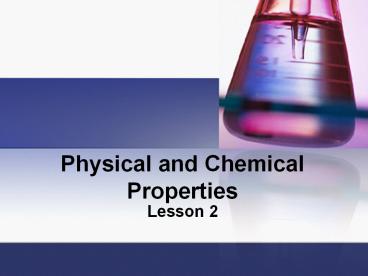Physical and Chemical Properties - PowerPoint PPT Presentation
1 / 20
Title:
Physical and Chemical Properties
Description:
Physical and Chemical Properties Lesson 2 Physical Properties -A physical property describes a characteristic of a substance that can be observed or measured without ... – PowerPoint PPT presentation
Number of Views:164
Avg rating:3.0/5.0
Title: Physical and Chemical Properties
1
Physical and Chemical Properties
- Lesson 2
2
Physical Properties
- -A physical property describes a characteristic
of a substance that can be observed or measured
without changing the composition of matter. - Example Melting Point, Boiling Point
3
- When water freezes it expands due to a special
bonding between water molecules. - Larger volume with the same mass Less dense
- This is why ice floats
4
Observing Physical Properties
Property Description Examples What it looks like
Colour and lustre The light the substance reflects gives it colour and lustre (shine) The names for some substances, such as gold, are also the names of colours. Gold has lustre concrete is dull
5
Observing Physical Properties
Property Description Examples What it looks like
Conductivity Conductivity is the ability of a substance to conduct electricity or heat. A substance that conducts electricity or heat is called a conductor. A substance with little or no conductivity is an insulator. Most metals are good conductors. Copper is a very good conductor of electricity and so is used to make electric wires. Styrofoam and glass are insulators.
6
Property Description Examples What it looks like
Density Density is the amount of mass in a given volume of a substance. D m/v The density of pure water is 1 g/mL. The density of gold is 19 g/mL. Water is denser than oil, but gold is denser than water.
7
Observing Physical Properties
Property Description Examples What it looks like
Ductility Any solid that can be stretched into a long wire is said to be ductile. Copper is a common example of a ductile material.
8
Observing Physical Properties
Property Description Examples What it looks like
Hardness Hardness is a substances ability to resist being scratched. Hardness is usually measured on the Mohs hardness scale from 1 to 10. The mineral talc is the softest substance on the Mohs hardness scale (1). Emerald is quite hard (7.5). Diamond is the hardest (10).
9
Observing Physical Properties
Property Description Examples What it looks like
Malleability A substance that can be pounded or rolled into sheets is said to be malleable. Aluminum foil is an example of a malleable substance. Metals such as gold and tin are also malleable.
10
Observing Physical Properties
Property Description Examples What it looks like
Viscosity Viscosity is the resistance of a fluid to flow. Honey has a high viscosity Compared to water.
11
Observing Chemical Properties
- A chemical property describes the ability of a
substance to change into a new substance or
substances. - In order to view a chemical property a chemical
change must occur. - Chemical change - the formation of a new
substance or substances with new properties. - A chemical reaction is a process in which a
chemical change occurs.
12
Chemical Properties
- 1. Combustibility is the ability of a substance
to burn. In order to burn a substance requires
Oxygen
13
Chemical Properties
- Light sensitivity is a chemical property that can
cause new substances to form when light hits it.
14
Chemical Properties
- 3. Reacting with an acid is a chemical property
where when acid is poured on a substance it
produces a gas and bubbles.
15
Physical Change
- In a physical change, the substance involved
remains the same (chemically). The substance may
change form or state, however. All changes of
state are physical changes. - Examples Dissolving a substance in a liquid,
breaking something. - NOTE Most physical changes can be reversed.
16
Chemical changes
- In a chemical Change the substance is changed
into one or more different substances. - The new substances have different properties from
the original substance. - Most chemical changes are difficult to reverse
and most cannot be. The new substances are not
likely to combine and form the original
substance.
17
- Often during a chemical change you cannot see the
change that has occurred in the substance, but
you can observe the results of the change. There
are clues that suggest that a chemical change has
taken place.
18
Clues that a chemical change has occurred
Clue Evidence
Change in colour Final product(s) may have a different colour than the colours of the starting material(s).
Formation of a solid (precipitate) Final materials may include a substance in a state that differs from the staring material(s) Precipitate
19
Clues that a chemical change has occurred
Clue Evidence
Formation of a gas Final materials may include a substance in a state that differs from the staring material(s) commonly, a gas
Release / absorption of heat or light Energy (light, electricity, sound or most commonly heat) is given off or absorbed.
The change is difficult to reverse The change cannot be reversed or it is difficult to.
20
Lab and Practice Questions hand in































